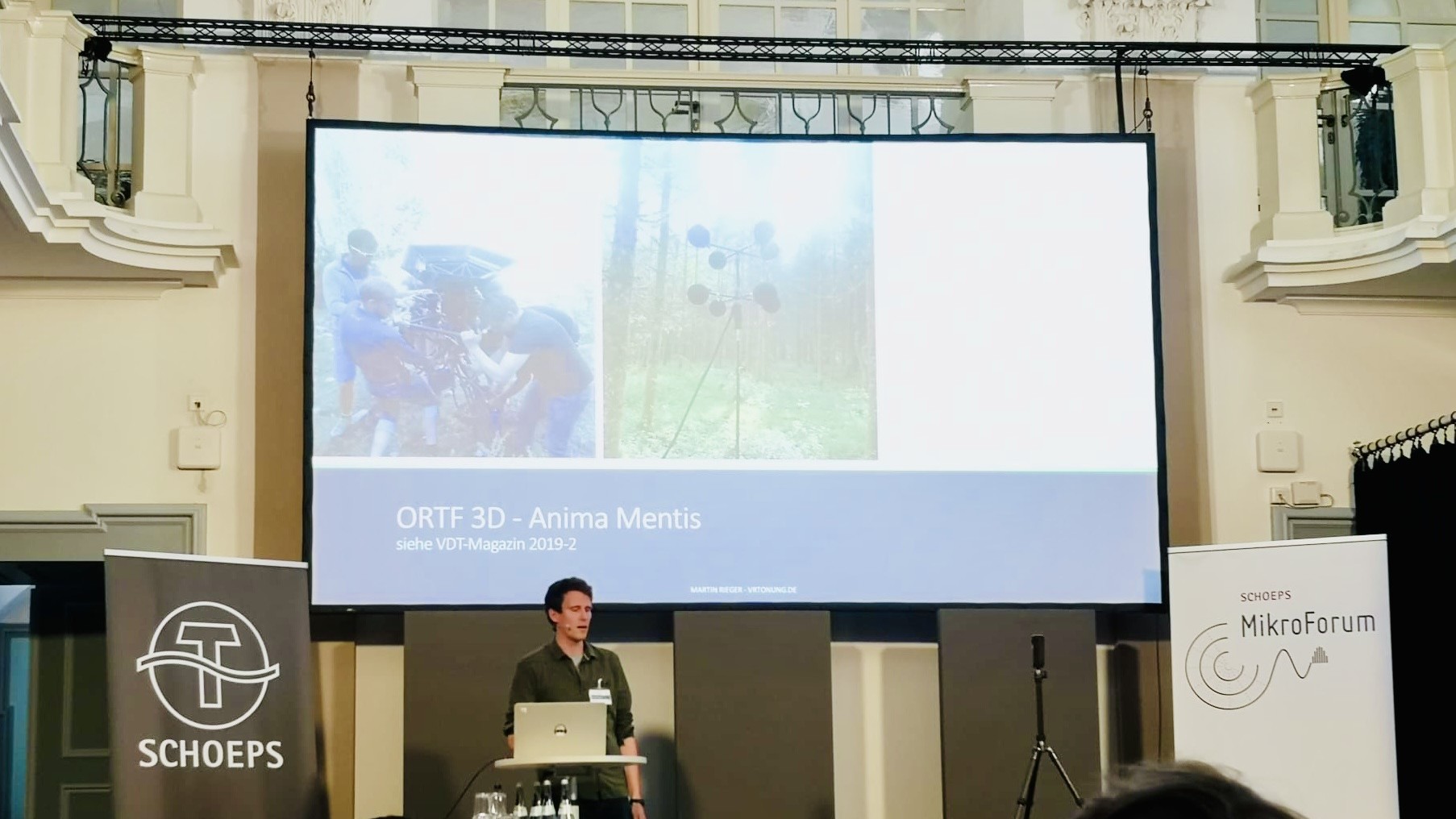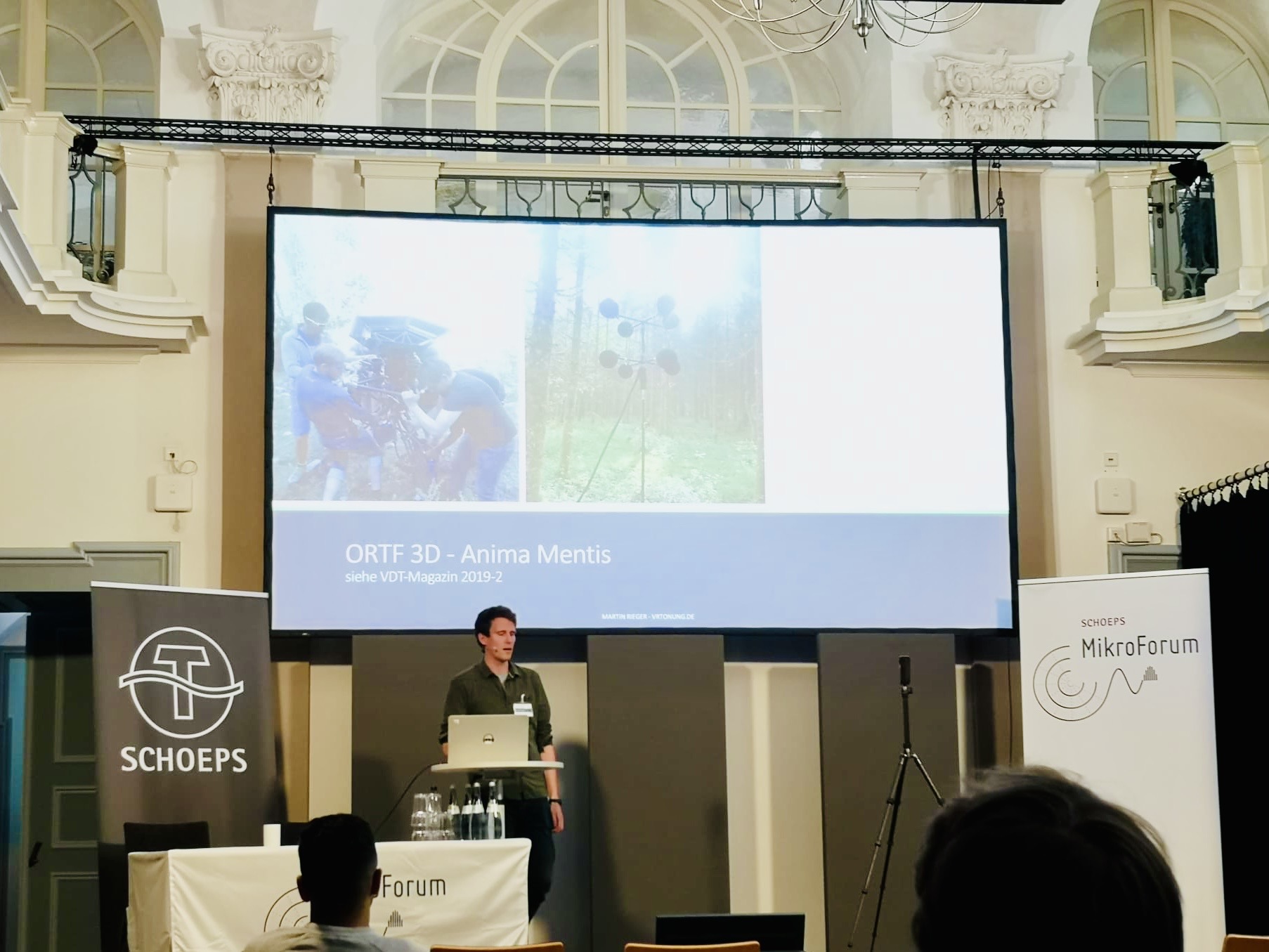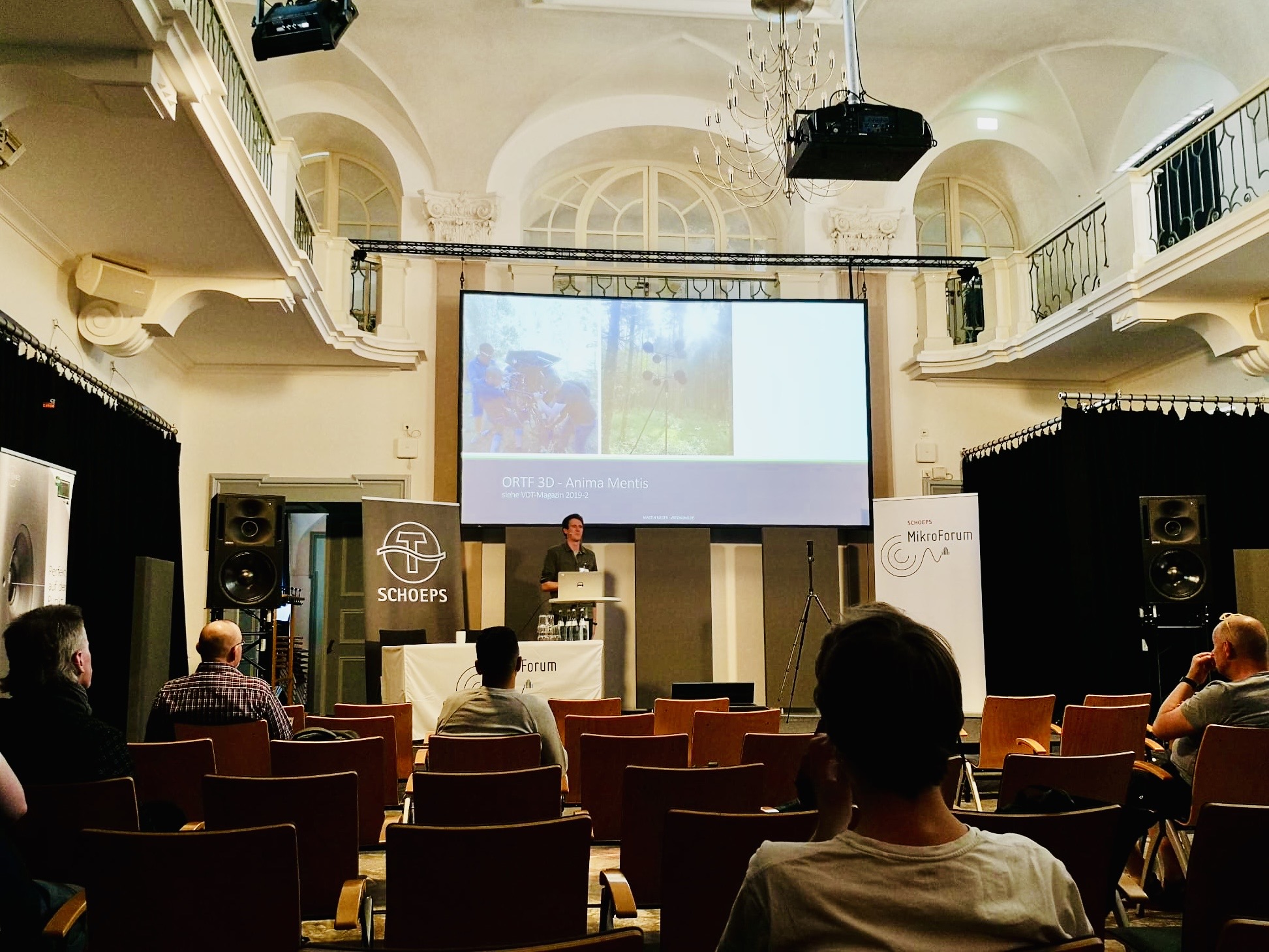
Schoeps MikroForum 2022: Audio Tutorial
To ensure that everyone can attend safely and in good health, we have rescheduled the 4th SCHOEPS MicroForum to a date in June: It will take place on 9 and 10 June 2022, as usual at Karlsruhe-Durlach Castle.
We, the exhibitors and speakers, are looking forward to a wonderful industry gathering in Karlsruhe, where the weather is sure to be warm, right after Pentecost. We look forward to seeing you there!
What can you expect?
The two-day lecture programme has already been organised and, as usual, consists of selected presentations and workshops on the subject of sound technology in music, film, movie, games and sports in stereo, surround, 3D and VR formats.
The event will cover different types of spatial audio formats, such as binaural and object-based sound, and how they serve different purposes in various listening environments.
The event will also feature a series of tutorials and workshops tailored specifically to the needs of beginners and advanced users.
We have once again invited numerous renowned speakers from all areas. We are also pleased to be able to show you around our company and introduce you to our development and manufacturing processes.
The workshops and presentations will also provide valuable tips for practical application. Attendees will have the opportunity for experimentation with new spatial audio techniques, exploring innovative approaches to immersive sound.
Finally, the accompanying exhibition with companies from the pro audio sector will ensure plenty of nerd talk in the foyer of Durlach Castle. You will also learn how to access spatial audio content through various platforms, including streaming services.
More information, a review of 2016 and 2018, the MikroThek with lots of videos and soon more details on dates and the programme can be found at www.schoeps.de/mikroforum.
About the event
The MikroForum follows Schoeps’ philosophy, offering many things at once. High-quality presentations and workshops, direct information from the manufacturers in attendance, and a friendly, informal atmosphere.
Most of the industry partners and speakers involved have been working together amicably for a long time. Another highlight is the factory tour that takes place as part of the Schoeps Mikroforum, where you can get an impression of the company for yourself.
Facilities
The venue is once again Karlsburg Durlach, which creates a unique atmosphere. In addition to the large, magnificent hall, this year a workshop room in the castle will offer the opportunity to give practical presentations with GENELEC 3D monitoring.
Specialized hardware and special equipment for immersive audio demonstrations, including setups for spatial audio and Dolby Atmos, will be available for hands-on experience.
The workshops will also provide practical instruction on the first steps in using modern audio software. Attendees will have the chance to work with leading DAWs such as Ableton Live, Logic Pro, and Pro Tools.
Cooperation agreements have been established with the VDT (Association of German Sound Engineers) and the AES (Audio Engineering Society). There will also be a meeting of the South Germany Section.
Basics of sound engineering
Anyone involved in audio and audio data processing cannot ignore the basics of sound engineering. Whether you are producing a song, creating a tutorial or working on a music project, understanding the different formats and the correct handling of tracks and channels is crucial for the sound.
Mastering these concepts is key to achieving a truly immersive audio experience.
An important step is selecting the right microphone for the recording. This is the only way to create high-quality audio files that can later be further processed in a DAW such as SOUND FORGE Audio Studio or Pro. Audio can be recorded in high-quality formats such as WAV files, and the resulting file is essential for further processing and distribution.
During recording, you should always pay attention to the level to avoid distortion and obtain a clean signal.
Audio data is usually edited in multiple tracks, with effects such as reverb or echo being used specifically to give the material more depth and spatiality. Headphones and speakers are indispensable tools for checking the sound in all editing phases and detecting errors at an early stage.
Our ears and the unique shape of each ear help us perceive sound direction and spatial cues, which is crucial for creating an immersive audio environment. Spatial audio technologies allow us to hear and listen to sound as we would in real life, enhancing the three dimensional listening experience and making the sound more lifelike and engaging.
Those who master the basics of sound engineering can not only make better recordings, but also work more flexibly and creatively in editing – whether in music, video or podcasts.
Production Stages and Planning
Creating compelling spatial audio content is a multi-stage process that requires careful planning and coordination. For sound designers and audio engineers, the journey begins in pre-production, where the creative team defines the project’s vision, target audience, and the type of immersive experience they want to deliver.
This is the stage where crucial decisions are made about which spatial audio format to use—be it Dolby Atmos for a cinematic surround sound effect or binaural audio for a lifelike headphone experience.
Selecting the right technology and equipment is essential. Depending on the project, this might involve setting up a multi-speaker system for a home theater environment or preparing for playback on VR headsets to support a fully immersive listening experience.
The planning phase also includes mapping out the soundscape, determining how different sounds will move through three-dimensional space, and ensuring that the production process will support the desired level of immersion.
Once the groundwork is laid, the production moves through recording, editing, and mixing, with each stage focused on maintaining the integrity of the spatial audio experience.
Post-production is where the final touches are added, ensuring that the audio delivers a seamless and engaging listening experience across all intended platforms and devices.
By investing time in thorough planning and understanding each stage of the process, creators can produce spatial audio content that truly captivates and immerses listeners.
Follow-up report


…is coming soon. In the meantime, follow the event on my Instagram – Account!
Microphone comparison: ORTF-3D vs. Ambisonics
Why the comparison is flawed
In my presentation, I wanted to show that comparing ORTF-3D and Ambisonics is often flawed – like comparing apples and oranges. Although both microphones offer 3D audio, they are designed for different situations and requirements.
In addition, the microphones fulfil different functions in the production process, which can be decisive depending on the area of application. Audio content is often created using these microphones and then delivered to audiences through various playback systems.
A multi speaker setup is frequently used to deliver immersive audio experiences in certain production environments, enhancing the spatial qualities captured or created during recording. The question of which microphone is best for a particular application cannot be answered in general terms, as the technology is either over- or under-utilised in certain contexts.
In the studio in particular, the choice of microphone can also influence the editing of individual songs, as different microphones open up different sonic possibilities. My motivation was to make it clear that there is no such thing as the ‘perfect’ microphone, but that you have to make the right choice depending on the project and the associated requirements.
360° video and VR audio techniques
Opportunities with VR sound I wanted to show people that when it comes to VR sound, we need to think about more than just the technology. Careful preparation is crucial for successfully planning and implementing VR audio projects.
The user’s line of sight controls their perception of the audio content, and you have to ask yourself whether everything really needs to be audible just because it is visible. An important point I raised is the idea of ‘credibility’ rather than ‘realism’.
It is not always necessary to go into every detail, but rather to create a hyper-realistic, immersive experience that makes the user feel like they are in the middle of the action.
Head tracking technology enhances this immersion by adjusting audio sources based on the listener’s head movements, making the experience more realistic. Ambisonics and ORTF-3D play a role here, but the right choice always depends on the type of project.
Apple Spatial Audio, for example, offers a 360-degree sound experience for users of AirPods and other Apple devices, using head-tracked spatial audio to further increase immersion.
The perfect microphone for 360° recordings What particularly interested me was the question of the ‘perfect microphone’ for 360° recordings. The truth is that there is no single microphone that perfectly meets all requirements. Depending on the recording, we have to distinguish between different microphone techniques such as ORTF-3D and Ambisonics.
It is important to consider the individual steps involved in selecting and applying the appropriate microphone technique in order to achieve optimal results. To fully experience spatial audio, it is essential to use a compatible device, such as headphones or VR headsets, which can accurately reproduce immersive sound formats.
For me, it was crucial to explain that priorities must be set – such as whether there are many mono objects or how many channels need to be processed in post-production. Technology alone cannot provide the solution; it must always be adapted to the specific situation.
Recording and microphone selection
Microphones for 360° recordings As a sound engineer in the immersive audio world, I know from experience that you can’t just choose a microphone without carefully considering the requirements of the project.
Microphones such as the Sennheiser Ambeo VR microphone or the Schoeps 3D-ORTF microphone offer various advantages and disadvantages.
Sennheiser offers a good solution for compact recordings, but when it comes to higher spatial resolution, the Schoeps microphone provides a more precise representation of the 3D audio environment – which pays off especially in more complex post-productions.
In my presentation, I wanted to show that each choice has its strengths and weaknesses, and it always depends on what you need in each situation.
Ambisonics vs. ORTF-3D Ambisonics is a very practical solution when it comes to post-production. It only requires 4 to 8 channels and is therefore particularly suitable for platforms such as YouTube or Facebook. The big advantage of Ambisonics is the flexibility of recording, but the ‘sweet spot’ for speaker playback is very small.
It shows its strengths on headphones, but can sometimes sound ‘washed out’ on speakers. ORTF-3D, on the other hand, offers more stable playback on speakers and also allows for high precision in head movement.
Although it is less flexible in post-production, it is an excellent choice for live broadcasts or studio recordings.
Distribution and Sharing
After the spatial audio mix is complete, the next challenge is distributing and sharing the content so that listeners can experience spatial audio as intended.
This involves preparing audio files in the correct formats for various platforms, such as streaming services like Apple Music, which support spatial audio, or video platforms like YouTube that allow for immersive soundscapes.
Sound designers must ensure that their spatial audio work is compatible with different playback systems, from stereo tracks for traditional listening to Dolby Atmos content for home theater systems.
Optimizing audio for a range of devices – whether listeners are using headphones, a multi-speaker home theater, or even mobile devices—is key to delivering a lifelike and immersive experience.
Each platform may have its own requirements for audio files, so understanding these technical details is crucial for successful distribution. By tailoring the audio work to fit the needs of each system, creators can ensure that their immersive soundscapes are heard as intended, reaching a wider audience and enhancing the overall listening experience.
Whether it’s music, movies, or interactive content, effective distribution is what brings spatial audio to life for listeners everywhere.
Creative Opportunities
Spatial audio opens up a world of creative possibilities for sound designers, musicians, and audio engineers. Unlike traditional stereo sound, which is limited to left and right channels, spatial audio allows creators to position different sounds anywhere in three-dimensional space.
This technology enables the creation of immersive audio experiences where listeners can perceive sound coming from various directions, distances, and even heights, making the environment feel more lifelike and engaging.
For example, in music production, spatial audio can be used to place instruments and vocals at different points in a virtual space, allowing listeners to experience a song as if they were standing in the middle of the band.
In film and video game production, spatial audio adds depth and realism, drawing the audience into the story and enhancing the sense of presence in a virtual world. The ability to create complex soundscapes with sounds moving dynamically around the listener transforms the way we experience audio, making it more interactive and emotionally impactful.
By experimenting with spatial audio, creators can push the boundaries of traditional audio production, delivering innovative and immersive experiences that captivate audiences. Whether it’s for music, movies, virtual reality, or live events, spatial audio technology empowers artists to craft soundscapes that are as rich and multidimensional as the real world.
Future prospects
The future of audio editing promises exciting developments and new opportunities for everyone who works with audio data, videos and music.
Innovative technologies such as artificial intelligence and machine learning are increasingly finding their way into audio data editing, enabling complex processes to be automated and new creative paths to be explored.
In the field of 3D audio in particular, immersive technologies such as virtual and augmented reality are opening up whole new dimensions for sound.
The demands on audio editing and mixing are increasing as users today expect an even more realistic and intense audio experience – whether in videos, live streams or interactive applications.
The ability to edit and convert audio data in different formats is also becoming increasingly important. New standards such as object-based audio and advanced formats ensure that producers and sound engineers can respond flexibly to the requirements of different platforms.
Anyone working with audio today should remain open to new technologies and be prepared to learn continuously. Development is progressing rapidly – and those who stay on the ball can actively shape the future of audio editing.
Conclusion
Focus on content rather than technology In conclusion, I wanted to make it clear that while technology is important, content should always be the focus. Immersive audio is often equated with 3D music, but it’s about more than that – it’s about storytelling.
Choosing the right microphone should not be based on the hype surrounding the latest technology, but on the needs of the project. The technology must support the story, not the other way around.
So when looking for the best microphone, you should always first consider the requirements of the content and the type of experience you want to create. This is the only way to ensure that the audio really enhances the experience and is not just perceived as a technical gimmick.